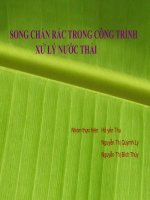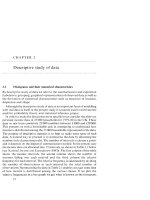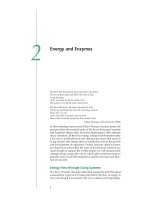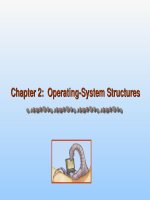Chapter 2 purchasing
Bạn đang xem bản rút gọn của tài liệu. Xem và tải ngay bản đầy đủ của tài liệu tại đây (441.52 KB, 24 trang )
Chapter 2
PURCHASING
MANAGEMENT
LEARNING OBJECTIVES
You should be able to:
• Understand the role of purchasing management and its
strategic impact on an organization’s competitive advantage
• Have a basic knowledge of the manual purchasing
process, e-procurement, public procurement, and green
purchasing
• Understand and know how to handle small value purchase
orders
• Understand sourcing decisions and the factors impacting
supplier selection
MBA Nguyen Phi Hoang©2015_SCM
2
LEARNING OBJECTIVES
(Continued)
You should be able to:
• Understand the pros and cons ( advantages and
disadvantages) of single sourcing versus multiple
sourcing
• Describe opportunities and challenges of global
sourcing and its impacts on supply management
• Understand and compute total cost of ownership
MBA Nguyen Phi Hoang©2015_SCM
3
CHAPTER OUTLINE
• Definition of purchasing
• Distinguish between Purchasing and Procurement
• The Role of Purchasing in an Organization
• The Purchasing Process
• Sourcing Decisions – The Make or Buy Decision
• Roles of Supply Base
• Supplier Selection
• How Many Suppliers to Use
• Purchasing Organization
• International Purchasing/Global Sourcing
• Procurement for Government/Non-Profits Agencies
MBA Nguyen Phi Hoang©2015_SCM
4
Definition of
Purchasing
Purchasing is an act of obtaining merchandise, capital
equipment; raw materials, services, or maintenance,
repair, and operating (MRO) supplies in exchange for
money or its equivalent .
Purchasing can be classified into two categories as:
Merchants – Wholesalers and retailers who purchase for resale
Industrial Buyers – Purchase raw materials for conversion,
services, capital equipment, & MRO supplies
The primary focus of this chapter is Industrial Buyer
MBA Nguyen Phi Hoang©2015_SCM
5
Purchasing vs
Procurement
The term “Purchasing” refers to the process of ordering and
receiving goods and services. It is a subset of the wider
procurement process. Generally, purchasing refers to the
process involved in ordering goods such as request,
approval, creation of a purchase order record (a Purchase
Order or P.O.) and the receipting of goods.
Procurement is the general function that describes the activities
and processes to acquire goods and services. Importantly,
and distinct from “purchasing”, procurement involves the
activities involved in establishing fundamental requirements,
sourcing activities such as market research and vendor
evaluation and negotiation of contracts. It can also include
the purchasing activities required to order and receive goods
MBA Nguyen Phi Hoang©2015_SCM
6
The Role of Purchasing in an
Organization
The primary goals of purchasing are:
Ensure uninterrupted flows of raw materials at the lowest total
cost,
Improve quality of the finished goods produced, and
Optimize customer satisfaction.
Purchasing contributes to these objectives by:
Actively seeking better materials and reliable suppliers,
Work closely with and exploiting the expertise of strategic
suppliers to improve quality and materials
Involving suppliers and purchasing personnel in new product
design and development efforts.
MBA Nguyen Phi Hoang©2015_SCM
7
The Role of Purchasing in an
Organization (Continued)
Purchasing can affect to:
Turnover and profit of organization
Product/service quality produced by organization
Prestige of organization
Purchasing partially decide the competitive
advantage and capability of one organization
MBA Nguyen Phi Hoang©2015_SCM
8
The Purchasing Process –
Manual Purchasing (older
system)
Step 1- Material Requisition/Purchase Requisition –
Stating product, quantity, and delivery date. May originate as a
planned order release from the MRP system. Traveling
requisition used for recurring( repeated) orders.
Step 2- The Request for Quotation (RFQ) –
Buyer identifies suppliers & issues a request for quotation
(RFQ) for routine items or a Request for Proposal (RFP) for
more demanding products.
Step 3- The Purchase Order (PO) –
Is the buyer’s offer & becomes a binding contract when
accepted by supplier. When initiated by the supplier on their
own terms, the document is a sales order.
MBA Nguyen Phi Hoang©2015_SCM
9
The Purchasing Process –
Manual Purchasing
Suppliers
Purchasing
Storage/Warehouse
Users/Requisition
Accounting
START
Materials
Requisition
MR 1
Materials
Requisition
MR 1
Materials
Available?
No
MR 2
MR 2
MR 3
Yes
Issue PO
Purchase
Order
PO 1
PO 2
Purchase
Order
PO 1
Materials
Requisition
MR 1
MR 2
PO 2
PO 3
PO 4
MR File
Accounting
Information
for charging the
appropriate
department
MR 2
Issue
Materials
Materials
+
DO 3
DO 2
Delivery
Order
DO 1
PO File
PO 3
MR File
DO 2
MR 2
Ship
Materials
+
DO 2
PO 2
MR 2
Materials
Delivery
Order
DO 1
INV 2
Invoice
INV 1
MBA Nguyen Phi Hoang©2015_SCM
Materials
+
Accounts Payable
PO 2
Delivery
Order
DO 1
Invoice
INV 1
Figure 2.1
10
The Purchasing Process –
Manual Purchasing
(Continued)
MBA Nguyen Phi Hoang©2015_SCM
Figure 2.2
11
The Purchasing
Process – Manual
Purchasing
(Continued)
MBA Nguyen Phi Hoang©2015_SCM
Figure 2.3
12
The Purchasing Process –
e-Procurement
Step 1- Material user inputs a materials requisition –
Relevant information such as quantity and date needed.
Step 2- Materials requisition submitted to buyer –
At purchasing department (hardcopy or electronically).
Step 3- Buyer assigns qualified suppliers to bid –
Product description, closing date, & conditions are given.
Step 4- Buyer reviews closed bids & selects a supplier
MBA Nguyen Phi Hoang©2015_SCM
13
The Purchasing Process
–
e-Procurement
MBA Nguyen Phi Hoang©2015_SCM
Figure 2.4
14
The Purchasing Process
–
e-Procurement
Advantages
of the e-Procurement System
(Continued)
Time savings
Cost savings
Accuracy
Real time
Mobility
Trackability
Management
Benefits to the suppliers
MBA Nguyen Phi Hoang©2015_SCM
15
Sourcing Decisions –
The Make or Buy
Decision
Outsourcing
–
Buying materials and components from suppliers instead
of making them in-house. The trend has moved toward
outsourcing.
Backward vertical integration –
Refers to acquiring sources of supply
Forward vertical integration –
Refers to acquiring customer’s operations.
The Make or Buy decision is a
strategic decision
MBA Nguyen Phi Hoang©2015_SCM
16
Sourcing Decisions –
The Make or Buy
Decision
Reasons
for Buying or Outsourcing
(Continued)
Cost advantage –
• Especially for components that are non-vital to the
organization’s operations, suppliers may have economies
of scale
Insufficient capacity –
• A firm may be at or near capacity and subcontracting from
a supplier may make better sense
Lack of expertise –
• Firm may not have the necessary technology and expertise
Quality –
• Suppliers have better technology, process, skilled labor, and
the advantage of economy of scale
MBA Nguyen Phi Hoang©2015_SCM
17
Sourcing Decisions –
The Make or Buy
Decision
Reasons
for Making
(Continued)
Protect proprietary technology
No competent supplier
Better quality control
Use existing idle capacity
Control of lead-time transportation, and
warehousing cost
Lower cost
MBA Nguyen Phi Hoang©2015_SCM
18
Roles of Supply Base
Supply Base - list of suppliers that a firm uses to acquire its
materials, services, supplies, and equipment
Firms emphasize long-term strategic supplier alliances consolidating
volume into one or fewer suppliers, resulting in a smaller supply base
Preferred suppliers provide:
Product and process technology and expertise to support
buyer’s operations, particularly new product development and
value analysis
Information on latest trends in materials, processes, or designs
Information on the supply market
Capacity for meeting unexpected demand
Cost efficiency due to economies of scale
MBA Nguyen Phi Hoang©2015_SCM
19
Supplier Selection
The process of selecting suppliers is complex and should
be based on multiple criteria:
Product and process
Cost
Total cost of ownership
technologies
or acquisition
Willingness to share
Reliability
technologies &
Order system & cycle
information
Early supplier
involvement (ESI)
Concurrent
engineering (CE)
Quality
Service
MBA Nguyen Phi Hoang©2015_SCM
time
Capacity
Communication
capability
Location
20
How Many Suppliers to
Use
Single-source - a risky proposition. Current trends favor
fewer sources.
Reasons Favoring a Single
Supplier
To establish a good
relationship
Less quality variability
Lower cost
Transportation economies
Proprietary product or
process
Volume too small to split
MBA Nguyen Phi Hoang©2015_SCM
Reasons Favoring
Multiple Suppliers
Need capacity
Spread risk of supply
interruption
Create competition
Information
Dealing with special kinds of
business
21
Purchasing –
Centralized vs.
Decentralized
Purchasing
Organization is dependent
on
many factors, such as market conditions & types
of materials required
Centralized Purchasing - purchasing
department located at the firm’s corporate office
makes all the purchasing decisions
Decentralized Purchasing - individual, local
purchasing departments, such as plant level, make
their own purchasing decisions
MBA Nguyen Phi Hoang©2015_SCM
22
Purchasing –
Centralized vs.
Decentralized
Advantages Advantages
-
(Continued)
Centralization
Concentrated volumeLeveraging purchase volume
Avoid duplication
Specialization
Lower transportation costs
No competition within units
Common supply base
Decentralization
Closer knowledge
of requirements
Local sourcing
Less bureaucracy
A hybrid purchasing organization
Decentralized-centralized (large multiunit org)- decentralized
corporate and centralized at business unit
Centralized-decentralized (large org w/centralized control)
centralized large national contracts at corporate level and
decentralized items specific to business unit
MBA Nguyen Phi Hoang©2015_SCM
23
International
Purchasing/Global
ReasonsSourcing
for Global Sourcing –
Opportunity to improve quality, cost, and delivery
performance
Potential Challenges –
Requires additional skills and knowledge to deal
with international suppliers, logistics,
communication, political environment, and other
issues
MBA Nguyen Phi Hoang©2015_SCM
24









